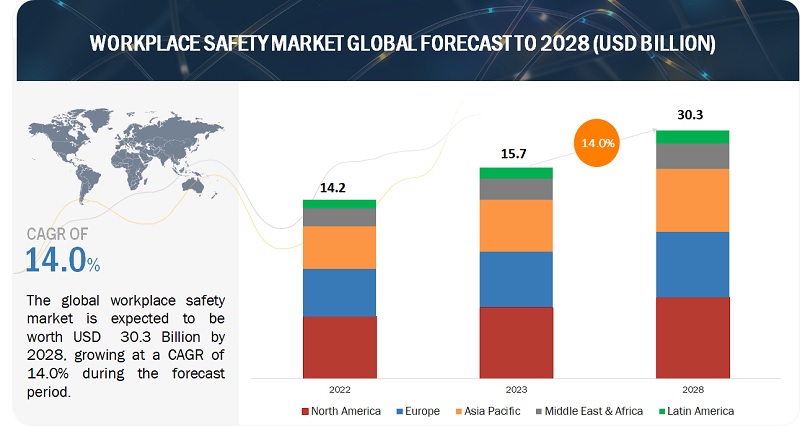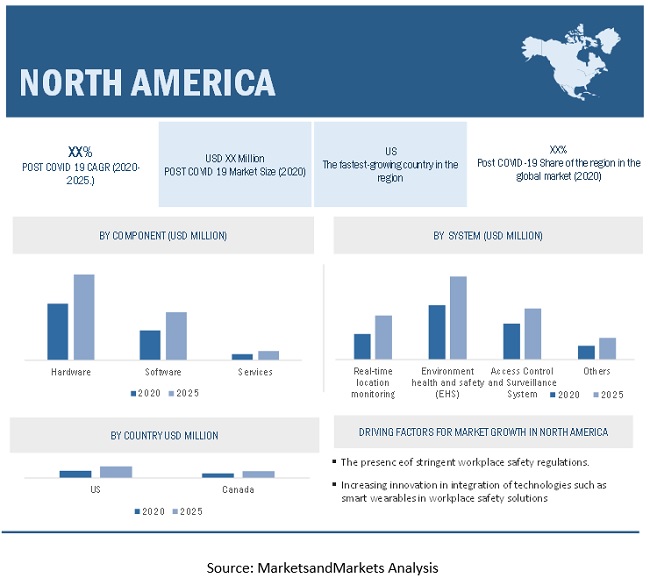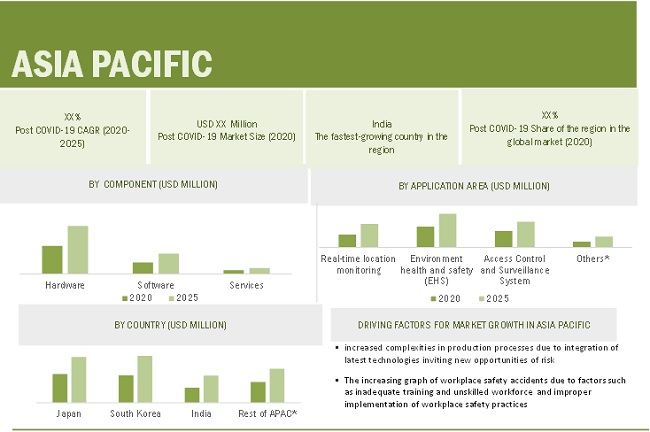< Key Hightlight >
The post-COVID 19 global workplace safety market size is expected to grow from USD 12.1 billion in 2020 to USD 19.9 billion by 2025, at a Compound Annual Growth Rate (CAGR) of 10.4% during the forecast period.
The major factors fueling the workplace safety market include substantial shift within industries towards a more holistic approach to health and well-being and increasing need for stricter safety regulations. Moreover, integration of Big Data and use of safety data as a predictive tool for risk management and introduction of new trends such as smart PPE, intelligent clothing, autonomous vehicles, and smart safety would provide lucrative opportunities for workplace safety vendors.

To know about the assumptions considered for the study, Request for Free Sample Report
COVID 19 Impact
With development as well as possibility of sooner deployment of vaccines for treating COVID-19, industries are slowly moving back to normalcy during the of the COVID-19 pandemic. This shift of workplace safety is expected to increase due to mandatory requirements of social distancing as well as continuous personal care through sanitization to eliminate even the slightest possibility of the spread of COVID-19. organizations are expected to update smart clothing to properly follow the norms of social distancing for ensuring smoother business functioning. If two workers come closer than the social distancing norms, the smart wearable will raise an alarm for both workers notifying they should move away from each other. This will help to curb the spread of COVID-19. Employers are expected to incorporate as well as mandate the application of these rules. Also, the outbreak of COVID-19 has also taught all the organizations a lot about being prepared for such uncertain and unprecedented times. Hence, regulators around the world are expected to introduce or update existing workplace safety regulations, which will be helpful during incidents, such as the COVID-19 pandemic, to curb the spread and keep workplace safety under control.
Market Dynamics
Driver: Substantial shift within industries towards a more holistic approach to health and well-being
Workplace safety has become an on-the-job priority for most companies across all industries, and several organizations realize the fact that a proactive approach to injury prevention and treatment reflects an organization’s commitment toward employee well-being. According to the National Safety Council, a worker is injured on the job every seven seconds. After the implementation of the Total Worker Health concept by The National Institute for Occupational Health (NIOSH), a substantial shift is being witnessed within the industry toward a more comprehensive approach to well-being beyond physical health. This multi-faceted approach includes social, emotional, financial, and environmental dimensions of health. After the implementation of this program, the focus of workplace safety programs has shifted from detecting unsafe conditions to identifying risks for prevention-based programs that emphasize education, training, and identifying issues before someone gets hurt. Employers are increasingly investing in the adoption of this standard, and hence, it is expected to drive the workplace safety market in the near future.
Restraint: Employees taking shortcuts and ignoring risks
This point of view is more safety-specific. Even after imparting training, some employees keep ignoring risks and taking shortcuts. If some of the employees take shortcuts, it motivates other employees as well to take similar kinds of risks due to which the worker, as well as workplace safety, is compromised. One of the best assets for addressing this challenge is other employees in an effective safety culture, employees will notice when others are taking unnecessary risks or otherwise behaving unsafely, and with proper training, they will speak up. This communication may mean even more coming from a fellow employee than from management. Unfortunately, there is a great deal of cognitive factors that prevent employees from speaking up when they see something unsafe. Hence, employees taking shortcuts and ignoring risks are a threat to the workplace safety market.
Opportunity: Introduction of new trends such as smart PPE, intelligent clothing, autonomous vehicles, and smart safety
The continuous rise in the integration of technology into workplace safety has opened doors for many other technologies. The use of Personal Protective Equipment (PPE) with sensors that monitor, collect, and record biometric, location, and movement data in real-time is on the rise. Mobile-based workplace safety tools, such as mobile inspection, incident applications that turn off workers mobile devices when they are completing essential tasks are expected to become more prevalent. The use of autonomous vehicles, such as self-driving cars are designed with sensors and software to follow road contours, avoid other vehicles, objects, bikers, and pedestrians, adjust to unsafe weather conditions, and anticipate dangers from situations that are developing on the road ahead is also increasing across various industries, such as production and manufacturing, heavy engineering works etc. The integration of these opportunities is expected to offer many lucrative opportunities for vendors of workplace safety solutions and services.
Challenge: Lack of skilled workplace safety and health professionals
Safety professionals are the people who have dedicated niche jobs for the purpose of helping with specific workplace health and safety related tasks, such as ongoing retraining, substance abuse management, personal safety equipment management, creating safety programs and more. According to OHS, a continued trend for 2020 is that safety professionals will perform many roles. With rapidly evolving workplaces, safety professionals are now tasked with multiple responsibilities and are more generalized in their respective approaches. Organizations need to direct safety professionals toward tools and resources that they can integrate into the workplace and help improve worker lives. Safety professionals equipped with all these skillsets are difficult to find. Employers are providing trainings to the existing safety professionals in order to equip them with the required skillset. Hence, the lack of workplace safety and health professionals is working as a challenge for workplace safety market.
Cloud segment to grow at a higher CAGR during the forecast period
The cloud deployment offers better control of the data, along with the reduced risk of data loss and concerns related to regulatory compliance. Owing to these benefits, several enterprises prefer cloud usage to ensure safety and security. The choice of opting for the cloud deployment type to deploy container security completely depends on the businesses’ needs and users’ requirements. The cloud deployment provides organizations with benefits, such as increased scalability, speed, 24x7 service, and enhanced IT security. The overall adoption of cloud-based solutions is growing at a good pace, and the trend is expected to increase during the forecast period due to the wide range of functionalities and core features these solutions provide. The low cost and ease of implementation are expected to have made cloud a highly preferred delivery model among large enterprises and SMEs.
Industrial end users to hold the largest market size during the forecast period
The industrial segment comprises oil and gas, automotive, aerospace and defense, mining, construction, energy and power, pharmaceuticals, and semiconductor. These industries are increasingly adopting workplace safety systems for adhering to guidelines and mandates regulated by OSHA. In energy and utilities, the adoption of EHS systems is significant because of the evolving EHS laws, regulations, and standards. The EHS ensures regulatory compliance, mitigates operational risks, and quantifies and reports air emissions from utility or energy system processes. The oil and gas industry uses RTLS and EHS systems to ensure smooth production in a safer environment. However, due to the ongoing investments by companies and governments in developing critical and smart infrastructure, the construction industry is expected to witness huge growth in the coming years. As the number of projects is expected to increase, the workplace safety market is also expected to grow in the construction industry.

To know about the assumptions considered for the study, download the pdf brochure
North America to hold the largest market size during the forecast period
North America is expected to be the largest contributor in terms of the market size in the workplace safety market. It is home to global innovative technology providers and filled with affluent and tech-savvy consumers demanding cutting-edge workplace safety solutions. According to a study from the National Opinion Research Center at the University of Chicago, 85 percent of workers rank workplace safety first in importance among all the labor standards. North America observes the North American Occupational Safety and Health (NAOSH) Week every year to help North American employers as well as employees to improve attitude toward safety, increase understanding of the importance of occupational health and safety, foster a safety-minded culture, and increase cooperation and raise awareness about occupational safety issues. The major factors driving the growth of workplace safety in North America include the strengthening of safety standards and government regulations. Increasing integration of technologies in workplace safety, such as smart sensors that can be integrated into fixed and portable devices for tracking and monitoring instruments, provide great opportunities to the vendors of workplace safety solutions and services in the region.
The increasing focus of APAC enterprises on maintaining a strong psychosocial safety climate due to increasing global competition and pressures for increased productivity will necessitate APAC enterprises to maintain the highest level of workplace safety in physical as well as psychological terms, further increasing the demand for workplace safety solutions, software, and services. Industries in APAC are increasingly embracing new technologies to boost efficiency, which is creating even more doors for potential new OSH risks, further fueling the demand for workplace safety solutions and services.

Key market players
Major vendors in the global workplace safety market include IBM (US), Honeywell (US), 3M (US), Hexagon AB (US), Bosch Building Technologies (Germany), and Cority (Canada).
Founded in 1975 and headquartered in Stockholm, Sweden, Hexagon AB provides geospatial and industrial sensors. The business divisions of the company include smart agriculture production solutions, geospatial data management solutions, geosystems, manufacturing intelligence, mining, positioning intelligence, and safety and infrastructure. The company has progressed in the workplace safety market by providing advanced command, control, and communication solutions, such as Intergraph Computer-Aided Dispatch, Intergraph Planning and Response, and Intergraph Security. Its breadth of offerings is limited to public safety software, and secure communications-based tools and software. These solutions provide the best-in-class features, functionalities, and support software, which help security teams in offering incident response and improving workplace safety. Hexagon AB is highly focused on innovations, and also invests significantly in R&D activities. The company caters to various industry End Userss, including government, public safety and security, transportation, and utilities and communications. It has a large employee base and regional offices set up in more than 50 countries.
Recent developments
- In November 2020, Hexagon and RealWear reshaped maintenance operations with connected workflows for the heavy asset industry
- In November 2020, Hexagon AB acquired PAS Global.
- In August 2018, Hexagon acquired External-Array.




